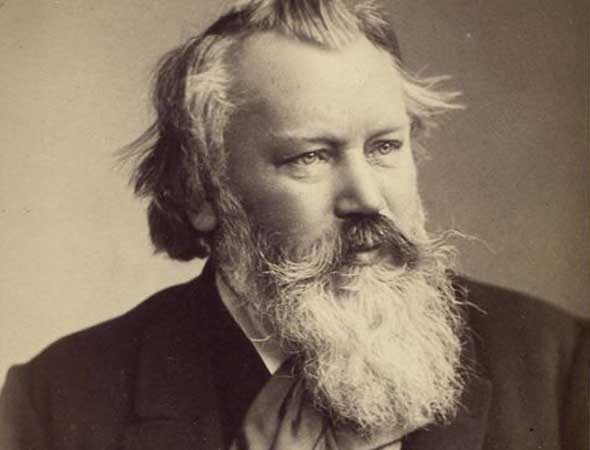BRAHMS: Symphony No. 3
By Jeff Counts
Duration: 33 minutes in four movements.
THE COMPOSER – JOHANNES BRAHMS (1833-1897). There was a “War of the Romantics” afoot in the second half of the 19th Century that dominated German musical thought. It was, in the simplest possible terms, a schism between Conservatives (who believed in the primacy of absolute, non-programmatic composition) and the Progressives (who cultivated a futurist ethic that pushed all referential and formal boundaries). Brahms was the unelected head of the traditional wing, and heavy indeed was the crown. He was mocked by followers of Liszt and Wagner, who found in his four symphonies all the stubborn anachronisms that defined what Liszt called the “posthumous party.”

THE HISTORY – That the third and possibly most humble of those symphonies of Brahms was premiered the same year Wagner died is both coincidental and important. As with most of Brahms’ new works in the last decades of the century, the December 1883 premiere of Symphony No. 3 was attended by avid, and hostile, Wagnerites. With their god only 10 months gone (Wagner had passed away in February), they were particularly keen to hiss Brahms’ stodgy creation into obscurity. It didn’t work. Fans of Brahms (who included Dvořák) made up the larger part of the audience and their voices rang loudest, as did those of the critics immediately after. It was one of the greatest triumphs of his career to date, but Brahms was no less afflicted by self-doubt for all the praise. More fascinating than any of the musical/political drama or the instant success that defied it is the fact that Symphony No. 3 includes at least one non-absolute (dare we say programmatic?) feature. Coded into the mighty opening chords of the first movement is the F-A-F motif from his younger days. These notes (F-Ab-F in this case) stand for Frei aber froh (Free but happy) and were originally meant as a response to Joseph Joachim’s personal motto Frei aber einsam (F-A-E – Free but lonely). The meaning of the Ab chord in place of the expected A is unknowable, but it is not hard to imagine something additionally extra-musical in this slight alteration. Was Brahms acknowledging, again, how equivocal and fragile his happiness often was? Regardless, the quotation flies in the face of his critics and proves that no artist is ever only one thing, or another. The writing of Symphony No. 3 took place over the course of a fleet four months in the middle part of 1883 and was done in Wiesbaden, not his usual Austrian mountain retreat. Apparently, Hermine Spies, a stunningly talented contralto and latest of Brahms’ unrealized infatuations, lived nearby. More subtext? More program? Who can say…
THE WORLD – Elsewhere in 1883, Life Magazine was founded in the US, Krakatoa erupted, the character of Pinocchio made his first appearance in Italy, Franz Kafka was born in Prague, and the last Quagga died in Amsterdam.
THE CONNECTION – The Utah Symphony has presented Symphony No. 3 many times on the Masterworks Series. The most recent performances were in 2016 with Thierry Fischer.











